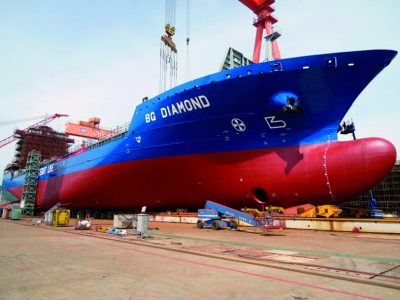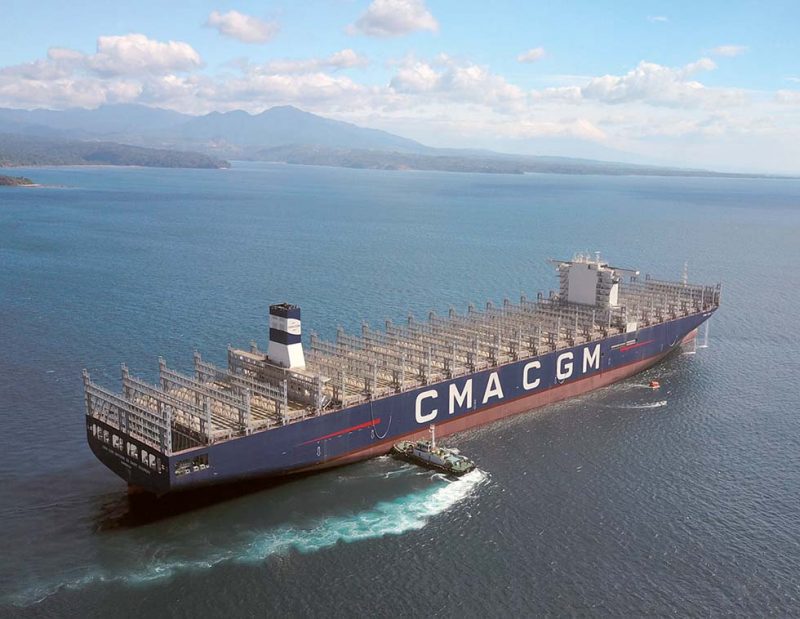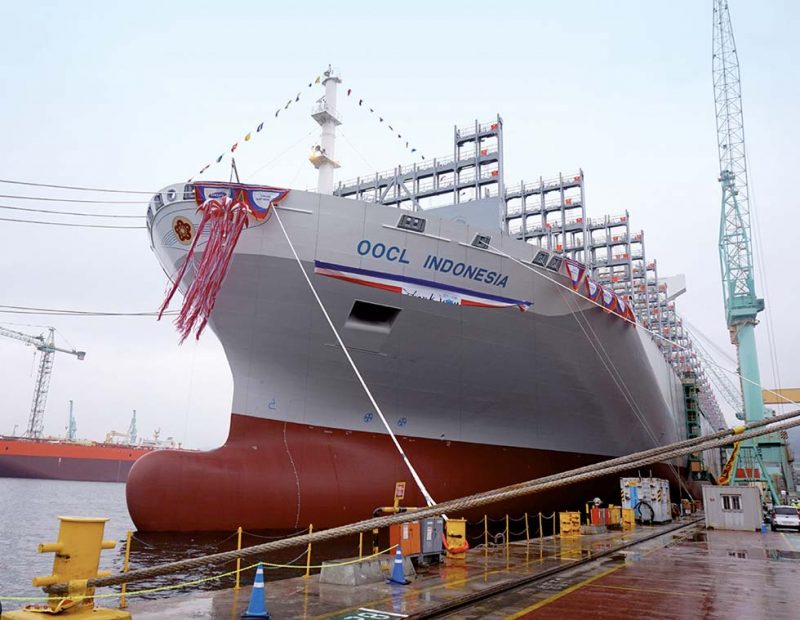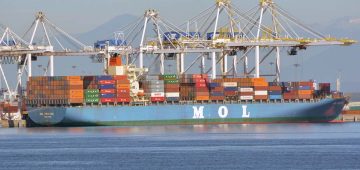
BG Freight Line’s 12,831gt/2017 built BG Diamond (above) made her maiden call at Cork’s Tivoli Container Terminal from Rotterdam in January. The brand new ship, developed by BG Freight Line in conjunction with designers CIMC ORIC and Arkon Shipping, is one of four brand new ships. The new BG Freight vessel is the maximum size of ship that the Tivoli Container Terminal can accommodate. The new facilities planned for Ringaskiddy Port Redevelopment, Cork Container Terminal will further improve the port’s capability to handle the growing Lo-Lo sector. The BG Diamond is fitted with state-of-the-art features such as a modern wet scrubber system for exhaust cleaning which complies with Emission Control Area requirements.
Blue Atlantic of Portugal has announced new plans for an 800m quay to berth two Panamax vessels at the Port of Setubal.
Blue Net Chartering was born on 1st February when Greek ship owner Costamare and Germany’s Peter Döhle Schiffahrts-KG officially teamed up in a joint venture. Headquartered in Hamburg, the chartering brokerage joint venture company began providing brokerage services for a fleet of 220 container vessels with an aggregate capacity of around 1.1 million TEUs.
Cargow has increased capacity by introducing the 9,717gt and 12,200dwt Frigg W as the primary member of a quartet of new and more environmentally friendly vessels. With this investment, Cargow BV plans to grow its liner traffic in Northern Europe, Norway and Iceland. The present services, operated for the past 5 years, include weekly sailings both northbound and southbound between Rotterdam and the West coast of Norway, and the East coast of Iceland.

CMA CGM took delivery of the first 20,600 TEU capacity containership built at the Redondo Peninsula Shipyard in Subic, the CMA CGM Antoine de Saint Exupery (above), from Hanjin Heavy Industries and Construction-Philippines Inc. on 25th January. The 217,673gt ship is 400m long with a 59m beam and 33m hull depth. The ship takes her name from the French aristocrat and literary icon Antoine de Saint-Exupéry. The steel was first cut for the ship on 8th February 2016 and she was launched 19th August 2017. The ship is the first of three to be built at the yard, can carry 123km of containers, and made her service debut on 6th February on the FAL 1 service (French Asia Line 1), the longest sea route in the world which connects Asia to Northern Europe. This line offers a weekly service to 16 ports of call with duration of 84 days. CMA CGM also extended its charter of the 8,063 TEU capacity, 89,097gt/2005 built GSL Tianjin, owned by Global Ship Lease Inc., as of 26th January. The vessel is chartered for a period of 8-12 months at a fixed daily rate. An investigation was started into the loss of containers from the 140,872gt/2017 built CMA CGM G. Washington while she was en-passage from Xiamen, China to Los Angeles, California on 20th January.
Containerships and Viasea Shipping have partnered up on a new fixed weekly route schedule to Norway with sailings from Klaipeda and Gdynia to Oslo. The first departure from Klaipeda will take place on 5th April. Short-Sea operators Containerships and Viasea are working within each company’s segments and areas. Containerships is operating in the Baltic Sea, whilst Viasea is mainly connecting the UK and continental Europe to Norway.
COSCO’s first 20,000 TEU capacity container vessel, the 196,670gt/2018 built Cosco Shipping Aries, underwent sea trials from the Port of Nantong after her naming ceremony on 16th January. The delivery sets a new record in the country as the first 20,000 TEU ultra large container ship built in a Chinese shipyard with independent intellectual property rights. The 400m long, 58.6m beam and 197,000 deadweight vessel is owned by COSCO Shipping Container Lines. The ship entered service on the Far East to Northwest Europe route on 19th January and was due to arrive at Piraeus, Greece, on 12th February, becoming the largest container ship to arrive at the Greek port to date. COSCO won a majority stake in the Piraeus Port Authority in 2016. Currently Piraeus is able to handle three 19,000 TEU vessels with no draught limitation plus one 10,000 TEU ship with a maximum draught of 13.8m.
Hudong-Zhonghua Shipbuilding, part of China State Shipbuilding Corporation (CSSC), also delivered the 154,300gt Cosco Shipping Alps, a 14,500 TEU capacity containership, to Cosco Shipping Lines on 3rd January, 56 days early. The 366m long and 51.2m wide ship is the third such ship delivered to Cosco thus far, the previous two being the Cosco Shipping Himalayas and Cosco Shipping Kilimanjaro, which were handed over in July and December 2017 respectively.
Diana Containerships of Athens, Greece, has reached an agreement to sell two of its 66,332gt/2004 built containerships, namely the March and the Great, with handover by the end of March. These ships had been employed by Yang Ming and had carried the YM prefix to their names. The company has also extended the present time charter contract with Hapag-Lloyd for the Sagitta, a Panamax vessel. The new charter period commenced on 15th February for a period of 3-5 months. Built by the Nordseewerke Emden Shipyard in 2010, the 36,087gt/2010 built Sagitta has a 3,426 TEU capacity.
Diana Shipping has also extended the present time charter contract with Hong Kong’s BG Shipping for one of its Panamax dry bulk vessels, the 41,342gt/2010 built Selina. The new charter period was expected to commence on 6th February. The 75,700dwt Selina was built at China’s Jiangnan Shanghai Changxing Heavy Industry and was previously named Sunshine,

Evergreen of Taiwan is to expand its fleet by adding twenty 11,000 TEU capacity ships, consisting of eight newbuildings and another 12 vessels on charter. The company’s two subsidiaries, Green Compass Marine and Evergreen Marine (Hong Kong), will each order four 11,000 TEU newbuildings and charter six vessels of the same type. The ships are planned to be delivered from the first quarter of 2020 through to the second quarter of 2021. Upon delivery, Evergreen said that it will redeliver older chartered vessels as their charter periods expire. The ship dimensions are 334m long, 48.4m wide, 15.5m draught and each vessel will have the ability to carry 19 rows of containers on deck. The service speed will be 23 knots, the dimensions allow the ships to pass through the Panama Canal and the hulls will be shorter than the new ultra large containerships plying the Asia-Europe trade. This will make the newbuilds easier to manoeuvre and the design also adopts the twin-island concept, separating wheelhouse and accommodation block from engine room and funnel area. The arrangement increases navigation visibility as well as the permissible height of container stacks on deck and therefore the cargo loading capacity.
Hamburg Süd is launching a new service network between Asia and South America’s West Coast, Mexico, Central America and the Caribbean in April. Operating under the ASPA & ASCA service names, the routes will be a completely new product to replace the present partnership with other liner shipping companies (Vessel Sharing Agreement) in this trade. Customers will benefit from additional direct connections, higher sailing frequencies, greater flexibility as well as shorter transit times. The existing Vessel Sharing Agreement between Asia and South America East Coast is not affected by the changes and is to continue until the end of 2018. The four new ASPA and ASCA service routes will see the deployment of a total of 39 modern vessels with a slot capacity of 4,500 to 10,000 TEU and will call at almost 30 key ports with several weekly sailings. In Asia, the primary container ports in China, South Korea, Taiwan, Japan and Singapore will be utilised whilst in Latin America, coverage ranges from Mexico, Panama, Colombia and Peru to Chile. Highlights for reefer customers are two weekly sailings from Chile to Asia as well as a direct service from Chile and Peru to Japan. One of the four new services additionally uses trans-shipment arrangements to link 24 ports in the Caribbean region with Asia, and vice versa. Furthermore, there is a connection to Hamburg Süd’s East Coast network via the north Brazilian port of Pecem.
Hapag-Lloyd is sending seven older 1998 built, 4,101 TEU capacity A4 Class container ships to be recycled in Turkey and China. The ships had been part of the UASC fleet.
Hyundai Merchant Marine’s (HMM) arrangement to collaborate with the 2M vessel sharing agreement (VSA) partners Maersk Line and MSC has seemingly come at a price for the South Korean shipping line. HMM’s capacity has fallen by 23.9% from 456,000 TEU in 2017 to 347,000 TEU at the start of 2018. The reduction is due mainly to the withdrawal of numerous HMM ships from the Asia-Europe and Asia-east coast of North America routes. The ships were chartered out to Maersk and MSC under a strategic co-operation agreement, known as 2M+HMM that took effect in April 2017.
The 141,868gt/2014 built and 365.5m long Hyundai Drive became the largest container vessel to make a maiden call in Qatar since the opening of Hamad Port. The vessel, laden with 13,154 TEU, arrived at Hamad Port container terminal CT1 from Kwangyang Port in South Korea on 13th January. The vessel had extended her Korea-Middle East service with a weekly call to Qatar.
HMM has also turned down fellow South Korean carrier SM Line’s offer to jointly operate on trans-Pacific services to the US East Coast in 2018. HMM had received the formal co-operation request on 9th January but this was declined as HMM was not completely assured of SM Line’s service reliability.
The combined market share of SM Line and HMM for U.S imports from Asia in 2017 was 6.8%, just below that of Hanjin’s market share in 2015. HMM’s 881,608 TEU shipped last year made it the number 8 carrier on the trade with SM Line’s 187,781 TEU making it number 15. CMA CGM/APL is the top carrier on the trade with 14.8%. In mid-February reports suggested that HMM was poised to order twelve 22,000 TEU and eight 13,000 TEU capacity newbuilds.
Kawasaki Kisen Kaisha (K Line) has taken delivery of the 14,000 TEU capacity containership Milano Bridge from the Imabari Shipbuilding Co.’s Hiroshima Shipyard in Japan. The new Panama-flagged ultra-large containership was handed over on 18th January 2018. The ship is the first of the second generation of K Line ships, a modified version of the 2015 built series of ships. K Line has five newbuilds scheduled for delivery this year, bringing its total number of ships to 10. The 150,706gt/2018 built vessel will be deployed on the Asia Mediterranean service (MED2) under the Ocean Network Express (ONE) shipping alliance, a merger between Japanese carrier lines Kawasaki Kisen Kaisha (K Line), Mitsui O.S.K. Lines (MOL), and Nippon Yusen Kabushiki Kaisha (NYK). The new company will become the sixth largest container shipping company in the world.
Maersk Line via the 2M Alliance will cease calls at Southampton on the AE1 (Asia-Europe 1/Shogun service after the departure of the MSC Diana on sailing 807W from Colombo, Sri Lanka on 28th February. The ship is expected at Southampton on 21st March. The first vessel not calling at Southampton will be the Marie Maersk on sailing 808W, departing Colombo, Sri Lanka on 7th March 2018. Southampton has been dropped as the 2M Alliance could not offer a reliable service with the previous number of port calls in the rotation. Thus, in order to improve service quality, it was decided to remove this call. Cargo for Southampton will subsequently be carried by a feeder service via Felixstowe until further notice. Alternatively, shippers can also book cargo onto the recently launched feeder service between Rotterdam and Bristol launched jointly by Maersk Line and European feeder specialist BG Freight Line, deploying a 1,000 TEU capacity. Maersk Line is launching a new service between Asia and Latin America in early April to provide new direct products for Colombia, the Caribbean and Pecem, Brazil. It will reduce transit times and offer greater port coverage, while maintaining the network’s leading reliability. To be known as the AC5, this fourth loop of the AC network will optimise Maersk’s Asia-Latin America-West Coast South America service. This is in line with Maersk’s ambition announced in December 2017 that the integration of Maersk Line and Hamburg Süd will offer customers better market coverage. Seaspan has acquired two 2006 built, 2,500 TEU capacity geared container vessels and placed them on charter with Maersk Line. The vessel identities were not available at the time of writing.
MSC’s 143,521gt/2012 built MSC Vandya was the subject of a new record after 223 containers per hour were moved during a call by the ship at Haifa Port on 12th January. The high performance level was successfully attempted to enable the ship to arrive on time at her subsequent call at the Port of Koper due to tidal constraints.
Navios Maritime Containers Inc. has acquired the 40,741gt/2010 built Navios Felicitas, a 4,360 TEU capacity containership. Following this acquisition, Navios Containers controls 21 vessels, totalling 88,820 TEU.

OOCL has launched the sixth and last in its latest series of 21,413 TEU capacity containerships, the 210,890gt OOCL Indonesia, christened at a ceremony held at the Samsung Heavy Industries (SHI) shipyard on Geoje Island on 17th January (above). Named by the ship’s sponsors Shirley Peng and Mary Liu, the newbuild began her maiden voyage later that month, joining her five sister vessels on OOCL’s Asia-North Europe Loop 1 (LL1) trade lane. The ship is 399.8m long with a 58.8m beam, a 32.5 hull depth, a scantling draught of 16m, an air draught of 73.5m and a deadweight of 191,317t. Her port rotation is Shanghai, Ningbo, Xiamen, Yantian, Singapore, through the Suez Canal to Felixstowe, Rotterdam, Gdansk, Wilhelmshaven, Felixstowe, and then back through the Suez Canal to Singapore, Yantian and Shanghai r.

TOTE of the U.S.A. is shelving plans for a new Jones Act service between the U.S. mainland and Hawaii due to complications in securing terminal space in Honolulu. As a result, TOTE will not progress with its Letter of Intent with the Philly Shipyard, which therefore expired on 31st January. This involved the construction of up to four custom built 3,700 TEU containerships for the Hawaii trade. The ships were given delivery dates of early 2020 (for the first two) and 2021 (for the second pair), and Philly Shipyard had even begun working on the vessels in order to ensure on-time delivery. Based on these developments, the project to build Hulls 031-034 as containerships was put on hold by the yard. However, the shipyard had placed orders for all major long-lead items for the first pair of ships. If these orders are to be cancelled, the costs will be substantially lower than the value of the orders placed. The Philly Shipyard is also exploring alternatives in order to secure contracts and financing for these halted vessels.




Comments
Sorry, comments are closed for this item